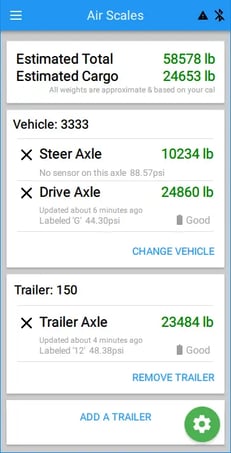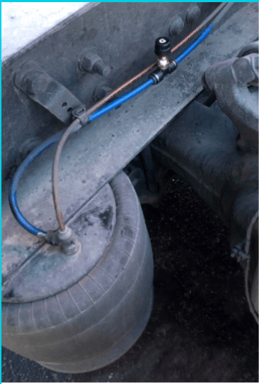
Being in the trucking industry one thing that drivers always have to look out for is making sure their gross and axle weights are legal. Getting overloaded can cause a lot of wasted miles and lost drive time if the only way you can get your weight is to drive off-site to a scale miles away.
We get thousands of requests from carriers and drivers who want to be able to easily get their gross and axle weights on their phones, tablets, and back office. One of the first questions people ask are "how much do the air scales cost?".
That is a difficult question to answer because it is kind of like asking "How much does a truck cost?". It depends on a lot of different factors like what your trucking set up is and what you want to be able to do with the data that you get from it.
In this post we will answer some of the common situations that carriers and drivers are trying to solve and how BIT Air Scales and the Blue Ink Tech system help with their efforts. We will also touch on how users leverage the BIT Air Scales to generate short-term savings and how they play into long-term growth in a trucking company.
Why Vehicle Weight Restrictions Exist
Vehicle weight restrictions are a heavily enforced area around commercial motor vehicles. The reason is because states use tax dollars to pay for infrastructure cost (roads, bridges, etc). Class 7 and class 8 trucks cause the most amount of damage on roads and bridges because of the heavy loads they haul.
To recover the damage, states collect taxes through IFTA, issue overweight permits and collect fines for trucks that violate road weight restrictions to help pay for the infrastructure. The Department of Transportation (DOT) manages weigh stations to scale trucks and make sure that they are not causing additional damage to roads for being overloaded.
If trucks were allowed to haul as much as they wanted then the cost to repair roads and bridges would come out of the states' taxes and would require tax increases on tax payers in the state. This is why vehicle weight enforcement exist.
Problems BIT Air Scales Help Drivers Avoid
When it comes to gross vehicle weight there are 6 major areas that carriers are looking to address when it comes to scaling loads.
Driving 30+ miles to scale loads
It is no secret that trucks get overloaded frequently at a shipper's site. When a majority of trucks are loaded today, they must drive to a scale to weigh their load to make sure it is legal. Many of these off-site scales can be over 30 miles away. If the driver is overloaded, they must decide if they are going to turn around to get something removed and lose all of those miles for the day. Alternatively, drivers may opt to drive past weigh stations and hope they don't get chased down by DOT.
Backtracking to adjust or remove cargo
Backtracking to a shipper's site is one of the costliest situations that a trucking company can face. The cost of driving back to the shipper impacts the effort of the driver, dispatch, brokers, receivers and carrier involving everyone to perform damage control and resetting expectations.
Revenue generating miles are impacted because the driver must perform this leg of the journey 3 times. Driving to the scale, back to the shipper and then back to the point where they originally scaled. This impacts the job's fuel cost and the time that is required to do this extra work eats into the driver's available hours-of-service. These setbacks also prevent the driver from reaching their anticipated destination.
Depending on the length of these trips and the time of day these events happen can also make the driver miss their original delivery window with the receiver. This can impact the carrier's reputation and relationship with the broker.
Being able to scale loads while the truck is being loaded eliminates all of the cost associated with these situations. Drivers who know that they are overloaded at a shipper's site can adjust 5th wheels or trailer tandem axles or get something removed before leaving a shippers site overloaded.
Paying to scale loads that are legal
Many drivers and owner/operators who have been burned by the burden of being overloaded have made it part of their routine to scale every load that they pick-up to verify the accuracy of the Bill of Lading (BOL). Most drivers who pick up 2 loads per week spend on average $1,200 per year just on scale tickets.
A majority of these loads are typically legal and under the required weight restrictions but are scaled for peace of mind. This means that the cost for the feeling of security for most carriers is over $1,000 per year per truck.
Driving back roads to avoid weigh stations
A common solution that drivers find when they discover they are overloaded is taking alternate routes through back roads to avoid weigh stations. This practice handicaps drivers' ability to maximize the amount of revenue generating miles they can make on a job. By taking routes off of the interstate there is more wear-and-tear on the truck and increased fuel usage which also eats into the profitability of the job.
This approach is also known by DOT, and many have been increasing their usage of portable scales to help catch drivers who are trying to avoid weigh stations while overloaded. Portable scale solutions allow the DOT to scale a truck during a roadside inspection and can result in fines if overloaded.
Violations and fines from DOT
DOT violations are the most noticeable expense when it comes to being overloaded because the cost can be hundreds to thousands of dollars depending on which state you are caught in.
While the cost of the fine is immediately noticeable there are other cost that come with getting these violations. In some cases, a driver can be placed out-of-service until the weight of the truck and trailer is fixed. The cost and labor of getting another truck out to address this situation add up very quickly.
DOT violations also impact a carrier's CSA score which can lead to situations such as: increased insurance rates, more frequent DOT audits, or getting put out of business for chronic violations.
Maximizing loads without going over
When hauling commodities that pay per pound, you want to be able to get as much that is legally possible without going over. If you load in the hills or in a field that is 50 miles from a scale getting your loads just right is critical. Drivers in these industries are most exposed to pressures from overloading.
Getting the weight of your loads at the point of loading dramatically lowers a driver's risk of being overloaded and drastically increases a carrier's opportunity to maximize revenue.
What value do BIT Air Scales bring carriers?
BIT Air Scale is an internet enabled weighing system that gives gross and axle weights to everyone in a carrier's operation. Unlike standard needle pressure gauges, BIT Air Scales allow carriers to have immediate access to current weights of every truck and trailer in operation at their desk.
This visibility increases accountability and helps drive user adoption across the fleet.
Real-time gross and axle weight
Drivers have immediate access to the steer, drive, trailer, gross and cargo weight of the trucks and trailers they use from day-to-day with over 99% accuracy compared to in-ground scales.

This allows drivers to know whether or not their loads are legal and allows them to adjust their axles to perfectly balance their load before leaving a shippers site.
By enabling drivers to get their weights while loading, carriers can save on all of the cost associated with paying for scale tickets, fuel used for scaling and back tracking and potential fines for being overloaded.
Carrier, dispatch and safety visibility
With Bluetooth-enabled truck scales, gross and axle weights can be shared with a carrier's entire team to help address issues before they turn into problems.
Dispatchers can log in to see which trucks are empty and ready for loads, how long drivers are waiting to get loaded and how far drivers are from their delivery points.
Safety staff can check to make sure loads are legal on gross and axle weight laws, which shippers are overloading trucks, which drivers are fixing and properly balancing loads. This helps the fleet avoid run away accidents, potential rollover events and reduces wear-and-tear on the fleet.
Easy record keeping
Being able to digitize vehicle weight data allows carriers to keep records more easily. Drivers and carriers can use their weight readings to generate scale tickets to print, send or email to anyone.
This kind of record keeping can be used to help with situations with shippers who try to coerce drivers to leave sites overloaded or aid in the FMCSA's Data Q process to appeal DOT violations.

What is involved with getting started with BIT Air Scale?
Getting started using BIT Air Scale is simple and easy when all of the required steps are performed properly.
Installation
Installing the BIT Air Scale sensors takes only 5-10 minutes to install on a truck or trailers air line. By finding the air line that feeds into the assets air bag all that is needed is a straight cut on the air line and push the line into that sensors DOT approved tee fitting.

Calibration
Calibrating the BIT Air Scales is a simple and straight forward process. To train the sensors on how pressure relates to weight on a truck and trailer, all drivers need to do is enter the steer, drive and trailer weights of the truck and trailer they are using when they scale.
The sensors require the truck(s) and trailers(s) to have 2 unique and accurate empty weights and 2 unique loaded weights to be entered at the time of scaling for the best accuracy.
Driver adoption
If carriers are looking to add BIT Air Scales to their fleet, it is important to develop an implementation plan that helps guide driver adoption. Drivers may be resistant to using and learning a new application. The best way to get drivers to use the sensors and the Blue Ink Tech application is to provide incentives early on to help build the habits you want for your fleet.
What are the costs to add a BIT Air Scale solution?
Until recently the cost to determine a truck's gross and axle weight at the time of loading was $1,200+ putting this solution out of reach for many owner/operators and small carriers.
Today, Blue Ink Technology can easily come in under $500 per standard truck and trailer set up making it a solid competitor to in-ground scales. In most cases BIT Air Scales pay for themselves in 2-3 months. The cost of not going with BIT Air Scales is significantly higher than not having an onboard scaling solution.

